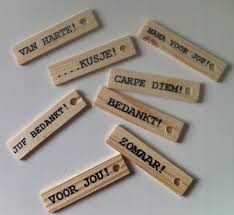Isn 't it at least a little strange? People who are gardening healthy and organic, and then use plastic pots and labels? Everything should be ecological in our garden, but we put a lot of garbage as plastics and synthetic ink in the ground. Of course, (?) even the air is full of pollutants .... But we can be more consistent. Under the influence of UV (in sunlight) plastics degrade and the particles went into the soil. And later probably also in our vegetables and bodies.
What natural materials and writing products can be used for garden labels?
Ceramics. Go for a workshop, and make your own cards. Written in wet clay, and baked afterwards. Provide any loose and reusable numbers and letters of the alphabet (in hearts, cards, chips ..).
You don’t like doing this job? You can also write with pencil on earthenware flowerpots (or fragments).
I often just use sturdy cardboard and pencil. No, I do not know if cardboard contains harmful additives. But board with an original base color will probably be better than colorful printed parts.
Aluminum is light, solid, very long lasting and weatherproof. Moreover, it is a soft metal, easy to saw or cut (depending on the thickness), in which you can also easily engrave or scratch. Or punch with a nail dots in it.
 Wooden slats. Use a crate, or split sticks you sand smoothly. You can write on it with a pencil. Or burn text on it with a hot soldering iron. Or any sharp piece of steel you heat. Very convenient and ready-to-use: the sticks of ice cream! (Or a wooden clothespin.)
Wooden slats. Use a crate, or split sticks you sand smoothly. You can write on it with a pencil. Or burn text on it with a hot soldering iron. Or any sharp piece of steel you heat. Very convenient and ready-to-use: the sticks of ice cream! (Or a wooden clothespin.)
Gather some shards of slate (of old roofs, roofer, walks ...). Earlier we wrote on it with a stylus. That is a little more weatherproof than chalk. But there is also water-resistant chalk of beeswax.
Shells of Ensis are because of the long and narrow shape, also known as "razor clams”. The content of this seafood is used in the kitchen, the shell can be used in the garden. Can be written on -as far as I know- only with some markers. Maybe someone knows a more environmentally friendly alternative? That potentially also can be used on (white) stones?
If you already have a few years gardened and weeded, you will recognize plants at a very early stage. And then there is really no label required.
Do you have multiple types of the same crop, you may notice that clearly in your garden booklet. You also want to know next year where you’ve planted the cabbage four years ago? Therefor you wrote it down. So basically you do not need a label. And that’s the same in seed trays.
And if there is still confusion possible, you can place an environmentally friendly number in plants, and note that in your garden book.
If you want the labels to hang on a sprig, use preferably no acrylic, nylon, raffia ed. Viable alternatives are metal (copper, iron, zinc), cotton (which is usually grown very environmentally unfriendly), rope flax, leather (laces of leftovers, skin), wool, horsehair, bark.
And while we're at it, replace the plastic containers by press pots, cardboard or pottery.
I'm not more catholic than the Pope. I do use a cheap, plastic watering can. Actually now already the 4th. Because if it breaks is you can only throw it away. Maybe I’d better once bought a sink (or galvanized) heirloom.
And in my socks is also acrylic.
But I do the best I can.
It is often easy and inexpensive. Sometimes seeming cheap. My watering can would have been much cheaper if I could continue to use my grandfathers. Went on for generations. Wondering how my grandchildren will think about it.
